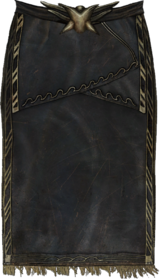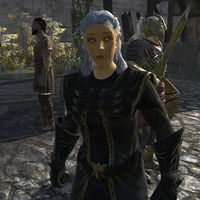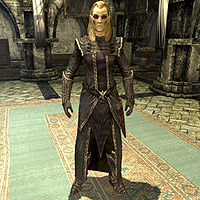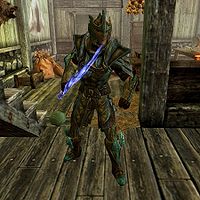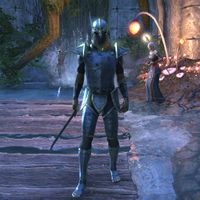Lore:Thalmor
The Thalmor refers to an Altmeri governmental organization that has served each of the three Aldmeri Dominions in varying capacities. It is also a general term for the members and paramilitary enforcers of that organization.
In the Fourth Era, the new incarnation of the Thalmor is a shadowy cabal that rules the Dominion, dedicated to Elven supremacy and "the pacification and purification of all of Tamriel – to bring about a new Merethic era".[1][2]:154
First Aldmeri Dominion[edit]
| This page or section is incomplete. You can help by adding to it. Add info about Ceythalmor For more information, see the help files, the style guide, and this article's talk page. |
The Thalmor began as an obscure Altmeri council within the government of the Summerset Isles that was tasked with safeguarding Altmeri heritage. With the ascension of Ayrenn to the Altmeri throne and the establishment of the First Aldmeri Dominion in 2E 580, the Thalmor's role was expanded to become the executive arm of the alliance, a bureaucracy that managed the Dominion's day-to-day affairs, investigate and enforce Dominion law, and liaised between its various local leaders and factions. It incorporated representatives from all three races in the Dominion's territory, in ratios appropriate to their administrative abilities. The Thalmor Inner Council served as Ayrenn's personal advisors, and included such notables as King Aeradan Camoran of the Bosmer and Lord Gharesh-ri of the Khajiit, as well as a number of other Bosmeri and Khajiiti nobles who were included largely as figureheads.[3][4][UOL 1]
Some organizations that existed prior to the Thalmor being elevated into a governmental position were later controlled by, or turned into direct divisions of the Thalmor. Two examples being the 'Fists of Thalmor'[3] and the Divine Prosecution.[5]
Second Aldmeri Dominion[edit]
During the Second Aldmeri Dominion, formed in 2E 830, the Altmer reconstituted the Thalmor as the new governing body of Valenwood. They claimed they had the authority to create this government on behalf of a claimant to Valenwood's throne, Camoran Anaxemes, whose ancestors had signed an ancient treaty with the Summerset Isles.[6] As Valenwood previously possessed no true, unifying government, the Thalmor purported to maintain order in the region to uplift their Bosmer brethren. In reality, the formation of the Thalmor was far from an altruistic gesture: the Altmer desired to control Valenwood because the region, along with southern Hammerfell, harbored various pirate groups which had long threatened the Summerset Isles. Fed up with the constant pirate attacks, the Altmer hoped to secure the shores of Summerset for good by denying the pirates any safe haven from which to attack them.[7] A significant figure within the Second Aldmeri Dominion, Andel Crodo, enforced a policy of non-intervention in non-Dominion lands, which few on the Thalmor sought to oppose.[8] The Thalmor was dissolved a short time later when Tiber Septim brought Valenwood into his Empire.[7]
Third Aldmeri Dominion[edit]
Rise[edit]
Sometime prior to the Oblivion Crisis in 3E 433, the Thalmor resurfaced as a radical and xenophobic political movement that espoused the absolute supremacy of Elves over all other Tamrielic peoples. For years they were largely ignored, but in the aftermath of the Oblivion Crisis they exploited the confusion to claim credit for the salvation of the Altmeri people, which greatly enhanced their influence.[9]
In 4E 6, the Thalmor incited the Argonians to mount a massive uprising against Morrowind and the Empire that was known as the Accession War. Black Marsh was lost to the An-Xileel, but the Thalmor too lost what influence they had over the Argonians. In 4E 22, the Thalmor overthrew the Altmeri monarchy and seized control of the Summerset Isles, renaming them Alinor.[10][11]
Valenwood was brought under the Thalmor's control in 4E 29, creating the Third Aldmeri Dominion.
The Night of Green Fire occurred in 4E 42, when the Thalmor attacked Altmer dissident refugees who had fled persecution in Alinor and were living in the city of Sentinel, in Hammerfell. According to a Legion officer claiming to be an eyewitness, there was an explosion of magic in the refugee quarter, where Thalmor mages were attacking the Altmer dissidents who, in turn, were resisting with magic of their own. Running to the scene with other Legionaries who were stationed there, the eyewitness found the entire refugee quarter a smoking ruin, and that everyone had been slaughtered. This night appears to have been part of a broader effort by the Thalmor, whose agents harassed the refugee communities in Sentinel and Balfiera, were somehow involved in Elsweyr, funded insurgent groups,[2] and were connected to a pattern of murders where the victims were all of mixed blood or had associations considered by the Aldmeri Dominion to be "unclean".[12]
In 4E 47, Prime Minister Hierem made a secret trip to Black Marsh to negotiate with the An-Xileel leaders supposedly to propose an alliance against the Thalmor.[12]:65 Intendant Marall of the Penitus Oculatus had Colin Vineben investigate if the Thalmor had summoned Umbriel, but he could find no evidence.[12]
The Elsweyr Confederacy voluntarily dissolved and reformed the ancient kingdoms of Anequina and Pelletine in 4E 115, which then became client states of the Thalmor.[11]
Great War[edit]
It is said that of all of his enemies, Emperor Titus Mede I never managed to defeat the Thalmor,[2] and it would be Titus Mede II who would pay the price. When Titus II inherited the Imperial throne, the Thalmor instigated the Great War in 4E 171 by delivering a series of ultimatums to the Imperial City, then presenting the head of every Blades agent who had been stationed in the Aldmeri Dominion when Titus II refused their demands. After four years of bloody war, a stalemate was reached. The Emperor was forced to sign the White-Gold Concordat, essentially giving in to the Thalmor's original demands. One of the Concordat's terms mandated that the Empire relinquish large tracts of land in southern Hammerfell to the Dominion, which outraged the Redguards and resulted in the secession of Hammerfell from the Empire. Fighting continued in Hammerfell, but the Redguards eventually forced the Dominion to the negotiation table and the Second Treaty of Stros M'Kai, which stipulated that Aldmeri forces withdraw from Hammerfell, was signed in 4E 180. This led the Redguards to believe that the Concordat was a mistake, and Titus II had overestimated the Thalmor's strength when he signed it. Another term of the Concordat was the outlawing of the worship of Talos, and the right of the Thalmor to enforce that ban within the Empire.
Rivercrest[edit]
Circa 4E 180, members of the Thalmor lead by Justiciar Aranande arrived in Rivercrest and other surrounding towns and villages, where they stated they were investigating for Blades agents. Henrik and the Warrior worked to hide their identities by leading the Thalmor on suicide missions and giving them false leads, with creatures such as bears and undead Ayleids killing Thalmor soldiers as they fell for these tricks.[13][14] The Thalmor were also tipped off on the location of a temple of Talos and intended to kill the worshippers there, however, the Warrior discovered the location of the Talos worshippers and warned them before the Thalmor could get to them.[15] After this, the Warrior also managed to kill a Thalmor messenger before they could relay information on who the hidden Blades were.[16] Eventually the Thalmor discovered the identity of Henrik and had him killed, but the Warrior avenged him by killing Justiciar Aranande.[17]
Skyrim Civil War[edit]
In the aftermath of the Markarth Incident in 4E 176 the Empire was forced to crack down on the worship of Talos in Skyrim in order to maintain the White-Gold Concordat, they permitted the Thalmor to operate inside Skyrim and suppress Talos worship when it had previously gone largely ignored. This persecution was a notable factor which led to the Stormcloak Rebellion.[18][19] By 4E 201, the Thalmor, well aware that Talos was especially revered by the Nords as both a god and a folk hero, were using the Concordat as a justification to carry out a campaign of persecution against Talos worshippers from their embassy in northwest Skyrim. Their branch in Skyrim at this time was overseen by Elenwen, and they have been known to secretly capture and imprison any Nords who question their doctrines or beliefs.[20] As of that time, there were reports indicating that Thalmor justiciars openly expressed hostility towards the Nords, with many individuals advocating for a genocidal agenda.[21][22] It is believed by important figures within both the Dominion and Empire around this time that the Thalmor were preparing for a second war.[23][24]
The Thalmor were unsure which side of the Civil War to support, though officially they supported the Empire in the name of stability. While they believed an independent Skyrim would weaken the Empire for whom they were planning renewed conflict, an independent Skyrim lead by Ulfric Stormcloak would have meant the end of their influence within the province they were enjoying. As such they adopted a policy to attempt to prolong the conflict for as long as possible. Though direct intervention was disincentivized, an exception was made to attempt to save Ulfric when he was captured for execution by Imperial forces.[19] This stands in contrast to cocurrent rumors that the Thalmor had assisted in Ulfric's capture.[25]:347
The sudden return of the Dragons was blamed on the Thalmor by remnants of the Blades within Skyrim. The Last Dragonborn infiltrated a party at the Thalmor Embassy on these grounds, only to find the Thalmor as in the dark as the Blades were.[26][27]
A Thalmor agent, Ancano, advised the Arch-Mage of the College of Winterhold at his pleasure.[28][29] Further agents assisted Ancano in his plot to secure the Staff of Magnus.[30]
Circa 4E 201, a Thalmor crew landed on Solstheim, sent on orders to retrieve weapons made of Stalhrim.[31]
In addition to the Thalmor Embassy in Haafingar, the Thalmor in Skyrim maintained a headquarters within Castle Dour and a fortress known as Northwatch Keep.
Gallery[edit]
See Also[edit]
- For game-specific information, see the ESO (First Aldmeri Dominion), Skyrim and Blades (Third Aldmeri Dominion) articles.
Books[edit]
- Regarding the "Fists of Thalmor" by Canonreeve Falduil — A missive regarding the nomenclature around the Aldmeri Dominion's justiciars
- Thalmor Handbill by Aicantar of Shimmerene, Sapiarch of Indoctrination — Thalmor pamphlet offering guidance for interacting with Khajiit and Bosmer allies
- Flight from the Thalmor by Hadrik Oaken-Heart — A written epitaph of a Nordic skald
- Rising Threat by Lathenil of Sunhold — A multi-volume series on the threat posed by the Thalmor
References[edit]
- ^ Loading screens in Legends
- ^ a b c The Infernal City — Greg Keyes. Del Rey Books, 2009.
- ^ a b Aicantar of Shimmerene Answers Your Questions — Aicantar of Shimmerene
- ^ Officer Parwinel's dialogue in ESO
- ^ Chief Justiciar Carawen's dialogue in ESO: Summerset
- ^ Pocket Guide to the Empire, 1st Edition: Aldmeri Dominion — Imperial Geographical Society, 2E 864
- ^ a b Pocket Guide to the Empire, 3rd Edition: The Wilds Remain: Valenwood — Imperial Geographical Society, 3E 432
- ^ Pocket Guide to the Empire, 1st Edition: Preface — Imperial Geographical Society, 2E 864
- ^ Rising Threat, Vol. II — Lathenil of Sunhold
- ^ Rising Threat, Vol. IV — Lathenil of Sunhold
- ^ a b The Great War — Legate Justianus Quintius
- ^ a b c Lord of Souls — Greg Keyes. Del Rey Books, 2011.
- ^ The Troll Trap quest in Blades
- ^ The Haunted Grove quest in Blades
- ^ The Freedom to Believe quest in Blades
- ^ The Messenger quest in Blades
- ^ A Friend in Need quest in Blades
- ^ Alvor's dialogue in Skyrim
- ^ a b Thalmor Dossier: Ulfric Stormcloak
- ^ Loading screens in Skyrim
- ^ Thalmor Justiciar's dialogue in Skyrim
- ^ Search and Seizure quest in Skyrim
- ^ General Tullius' dialogue in Skyrim
- ^ Ondolemar's dialogue in Skyrim
- ^ The Elder Scrolls V: Skyrim: Legendary Prima Official Game Guide — David Hodgson
- ^ Delphine's dialogue in Skyrim
- ^ Diplomatic Immunity quest in Skyrim
- ^ Ancano's dialogue in Skyrim
- ^ Mirabelle Ervine's dialogue in Skyrim
- ^ Estormo's dialogue in Skyrim
- ^ Ancarion's dialogue in Skyrim
Note: The following references are considered to be unofficial sources. They are included to round off this article and may not be authoritative or conclusive.
| ||||||||||||||
